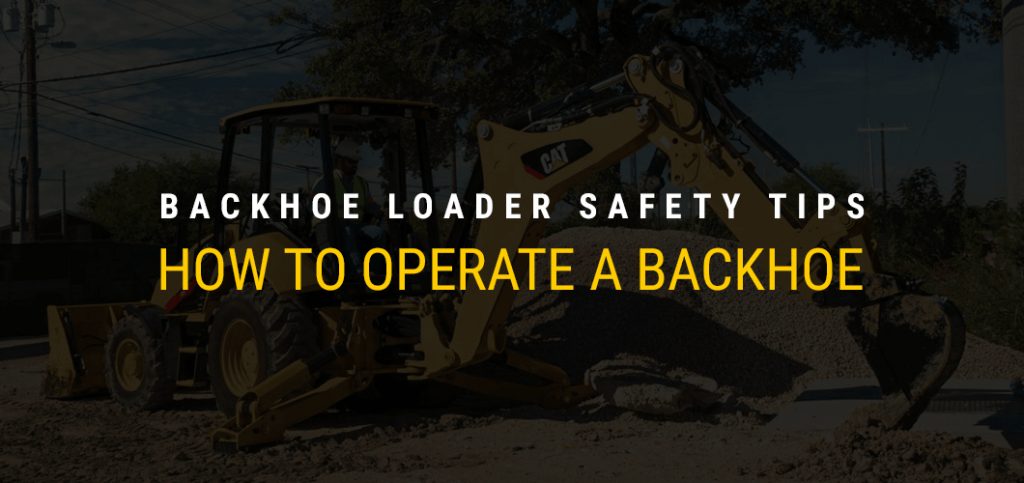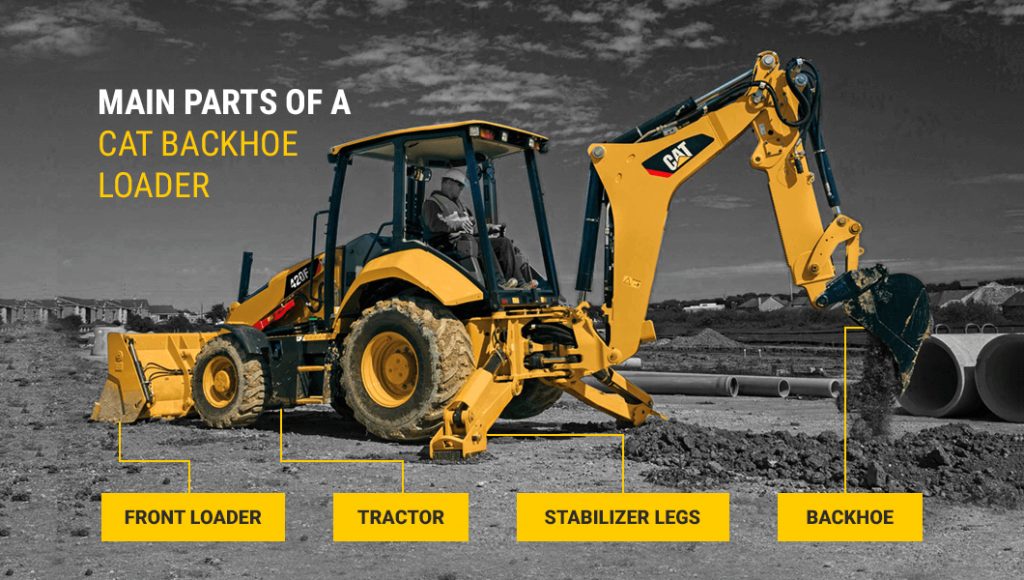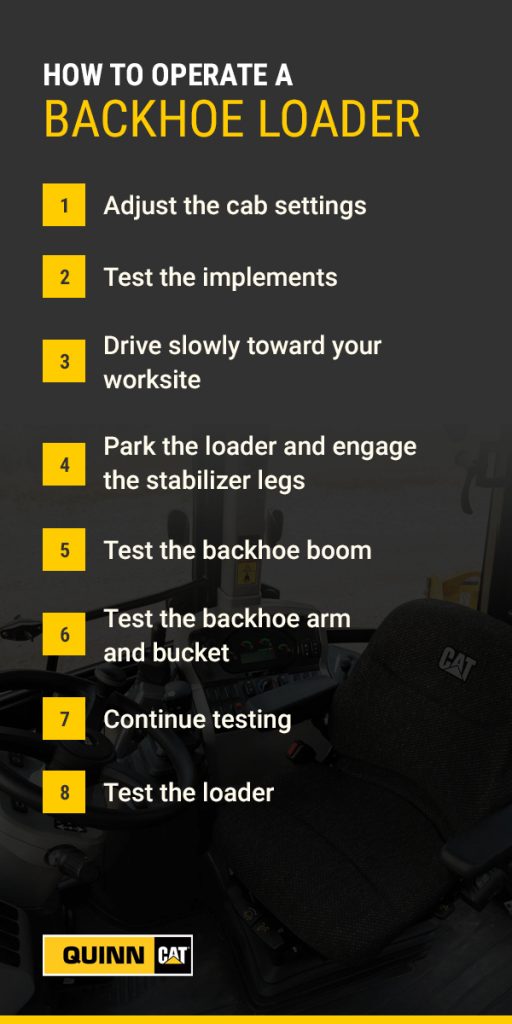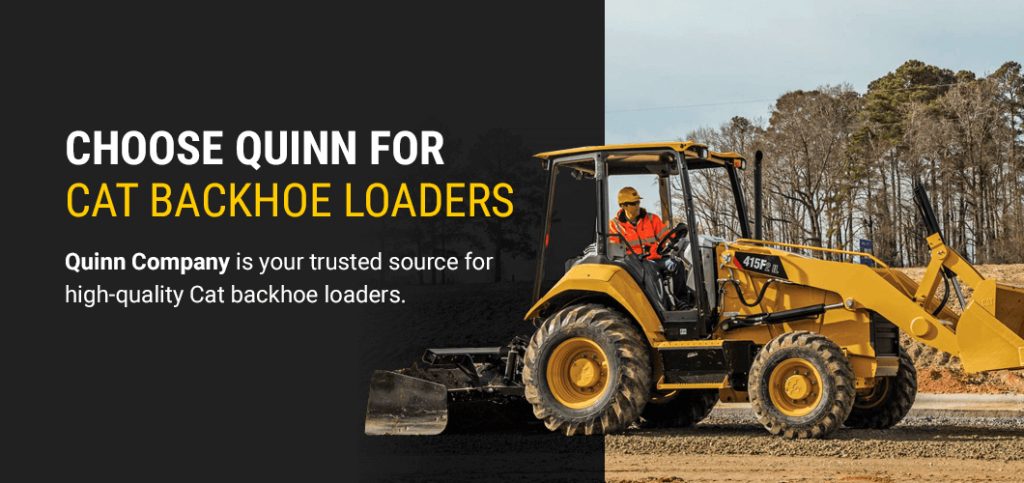
Backhoe loaders are versatile machines widely used across construction, landscaping and agricultural sites worldwide. The global sale and distribution of backhoe loaders is a billion-dollar industry, and it’s easy to see why. Backhoe loaders are reliable, multi-purpose tools that deliver unparalleled versatility across a variety of industries. Visit any worksite anywhere in the world, and you’re sure to find a backhoe loader dutifully waiting to be put to work.
Despite how familiar you are or aren’t yet with backhoe loaders, it’s vital to know the most basic safety protocols and operational practices. In this guide, we’ll discuss how to operate a backhoe, plus the fundamental operating steps and some tips for using a backhoe safely so you can prevent accidents.
Jump To Sections:
- What Is a Backhoe Loader
- Main Parts of a Cat Backhoe Loader
- How to Operate a Backhoe Loader
- Choose Quinn for Cat Backhoe Loaders
What Is a Backhoe Loader?
Backhoe loaders are a type of multi-purpose industrial tractor that serve two primary functions. As the name suggests, the backhoe loader can both dig and load, with its boom and stick at the back end and its bucket loader at the front. The boom and stick allow you to excavate, from digging trenches to loosening up earth, as well as lifting and placing materials. The front loader allows you to scoop and move earth, such as to backfill and grade a lot and smooth out terrain. Since the seat swivels 180 degrees, you can easily transition from front to back operation as needed.
Backhoe loaders are designed for small to medium-sized projects. They’re versatile in urban engineering, construction and agricultural settings. Typical backhoes, such as the Cat® F Series Backhoe Loaders, have a dig depth of roughly 14 feet and have a load capacity of over 2,400 pounds, making them mightier than they appear.
Backhoes are compact with two smaller front wheels and two larger rear wheels, giving these machines high maneuverability on narrower job sites where larger, specialized machines might struggle to operate efficiently. That’s also why you might have found yourself behind a backhoe loader — they’re not too oversized for the average public roadway. Backhoe loaders are one of the most relied upon heavy machines in the world, helping increase productivity and speed up projects safely and with less effort.
Browse Our Backhoe Loaders for Sale
Main Parts of a Cat® Backhoe Loader
When operating one for the first time, it’s important to familiarize yourself with the parts of a backhoe. Getting to know the basic structures of a backhoe loader and what they’re for will help you learn how to safely operate one. The following are the basic components of a backhoe loader, plus their purposes and functions:

- Tractor: The core of the Cat backhoe loader is the tractor — an all-terrain vehicle capable of moving across uneven ground thanks to its even weight distribution and heavy-duty tires. Like all vehicles, the backhoe loader has a cab with operating controls, like a steering wheel and gas and brake pedals. Depending on the model, a backhoe may be completely enclosed or partially covered.
- Front loader: At the front of the tractor is a hydraulic loader bucket that you can vertically control. The loader can lift and move loose materials, plow through debris or smooth out dirt. The front loader is compatible with different Cat work tool attachments for further multi-tasking.
- Backhoe: The backhoe is the rear component of the backhoe loader. It’s composed of a boom and stick (or dipper) where the work tool gets attached. The stick adjusts vertically, like an elbow joint. At the end of the stick is where the bucket, or another work tool, attaches.
- Stabilizer legs: Behind its rear wheels, the backhoe has two stabilizer legs. Engaging the stabilizer legs while digging raises the wheels off the ground, alleviating weight and strain off the tractor. Stabilizer legs are a critical safety feature that protect the equipment and prevent the backhoe loader from tipping.
How to Operate a Backhoe Loader
Safely and properly operating a backhoe to its fullest extent requires a lot of practice. It takes a while to get the hang of, and it’s not something you can just pick up overnight. When learning how to use a backhoe loader, it’s important to start out slowly. For a snapshot on safe operation, follow these tips for operating a backhoe:

- Adjust the cab settings: Begin by climbing into the cab and making the necessary ergonomic adjustments, such as seat depth and height, steering wheel tilt and pedal angles. Familiarize yourself with the joystick controls, throttle and the locking mechanisms for the loader and backhoe, as well as your accessories like lights, wipers and the horn.
- Test the implements: Fire up the engine and allow it time to warm-up. Then, test your implements. Engage and release the stabilizer legs. Gently raise and lower the backhoe boom and front loader to get a feel for their power.
- Drive slowly toward your worksite: Lift and secure the boom, stabilizers and loader. Release the parking and shift the transmission into forward. Slowly drive forward, remaining only in first and second gears. It’s normal for backhoe loaders to generate a lot of bounce, but slow down if it feels too rocky.
- Park the loader and engage the stabilizer legs: Drive the loader toward a test work area that’s on even terrain and clear of obstructions. Keep in mind that the boom swings to the right, so you’ll need plenty of side clearance as well as front, back and overhead clearance. Lower the stabilizer legs until the rear wheels are raised off the ground but keeping them as low to the ground as possible to maintain stability. Next, raise the front wheels enough so that the front bucket fully clears the ground in its lowered position. If you’re on a slight slope, adjust the stabilizer legs side-to-side as needed to ensure the rear of the machine is level.
- Test the backhoe boom: Swivel your seat so you’re facing the rear (the backhoe end). Begin by unlocking the boom with the lever or release mechanism. Using the left joystick control, gently push the control away from you, lowering the boom down toward the ground. Reverse this action by pulling the lever back toward you to raise the boom back up. Shift the control left to right to swivel the boom accordingly.
- Test the backhoe arm and bucket: Using the right joystick control, you can now test the backhoe arm and bucket. Pull the control toward you to bring the arm and bucket toward the cab. Reverse by pushing the control away from you to send the arm and bucket outward. Moving the control to the left curls the bucket to dig. Moving the control to the right releases the bucket to dump.
- Continue testing: After testing each of these control moves independently, you can begin putting them together to perform fluid movements. Continue repeating these controls gently until you’re able to comfortably maneuver the backhoe.
- Test the loader: Raise and lock the backhoe boom and arm in place and swivel to the front of the cab. Release the stabilizer legs until all four wheels are back on the ground. Turn the machine around so your loader is now facing the dug up hole. Slowly push the material back into the hole you dug by driving forward with the front bucket lowered, lifting and dropping the earth to backfill the hole. To secure the backfilled hole, drive over it to compact the earth tightly. Put the loader in reverse and drive back over the area with your bucket down. This will help smooth out the terrain evenly.
After performing a few of these test runs, you should develop a feel for how to operate a backhoe loader. Keep practicing, and don’t forget to reference your Operation and Maintenance Manual regularly to fully educate yourself about your backhoe loader’s capabilities.
Choose Quinn for Cat Backhoe Loaders
Backhoe loaders are a reliable and versatile heavy machine, practical in a variety of scenarios. But, as with any piece of machinery, it’s vital to become familiar with how to operate your backhoe properly. This ensures you operate the machine as intended, so you can prevent accidents and unnecessary wear and tear.
Whether you’re looking to invest in your own backhoe or you’re interested in backhoe loader rentals, Quinn Company is your trusted source for high-quality Cat backhoe loaders. Contact us today for more information by calling 1-888-987-8466, or stop by one of our convenient locations.


